
Transcription
THE BIG ONE
We used a small bait net to catch a few tinker mackerel. We put them in a live well and prayed they would stay lively until we reached the bank. A good swimming mackerel can do so much in drawing a tuna under the boat. Get that big bastard under there and then the odds are more in my favor. I'll fool him. I'll get him to take a hook-bait.
We steamed due east our of Gloucester Harbor. A nice flat and windless day with temperatures in the mid 80s. Perfect tuna killing weather as far as I was concerned. The Japs had been paying anywhere from $8.00 to $25.00 per pound the past couple of days and a big horse could well be worth give figures. The fish were there and I was feeling it in my fut, as a fisherman does, that one had my name on it.
I went through the handlines and made sure there were no visible flaws. I sharpened the hook tips and reset the harpoon rig. The groundline box was so well groomed that it would come out like silk when we hooked up. We were ready.
We hit the northwest corner of Stellwagon bank at about 7 AM, and it took about fifteen minutes to get the anchor fetched up so that the boat was hanging with the tide. We tossed over a few trial chums to gauge which was the tide was running and how fast. I dragged the cooler with the prime hookbait chunks down the deck and put the best looking two aside for the down line and line #2. I figured I'd fish the down line at 40' and the #2 at 60'. The last three lines would all have swimmers on them and they would be fished in staircase fashion at 90', 120', 145'.
It would be difficult to get the hooks directly in the chum slick today as the tide was running with a fury. My hopes were that the action of the swimmers would overcome any worries I had in that area as the scent of the chum in the water would lure a fish close enough so that the swimmers could do their job of getting him under the boat for a closer investigation.
The swimmers were hooked in through the mouth and out through the eye as they can swim and breathe real nice like that. I cut their swimming fins and blinded them in hopes of slowing their avoidance of any preying tuna. I don't really know if blinding them does much good as my grandfather used to liken it to a blind man standing on the railroad tracks. He still knows the train is coming. A 900 pound giant atlantic bluefin tuna is mother nature's locomotive, but the blinding technique is a ritual tradition and we dare not break tradition.
All five hooks were in place and we started the chumming process. You can't pay it over too heavy as you don't want to draw sharks, but you've got to toss enough to put the scent in the water while giving any would-be customers tid-bits to nibble on. I made an adjustment on the screen of the fishfinder so it would give us an optimal view as to if any fish were taking an interest. I kept my eyes glued for anything coming up the chum slick or gawking at the strong swimming mackerel. We use Prestone anti-freeze bottles for bobbers and the small mackerel were doing their damnest to haul them around. The line is heavy and attached to the funnel of the boat so they really can't move them buch, but it lets us know they are in good shape when we see them trying.
The hooks are crimped on to 600 pound test monofilament line leaders. It's strong as shit and can land a fish three times its weight rating. You just can't let it get nicked. We use what is considered a particularly long handline leader of 36'. We figure the further from the hook we keep the swivel the better as these fish have such great eyesight.
The leader is barrel swiveled to about 100' of military parachute cord we dye red. A diver once told us that the color red disappears first as he descends into the depth. We take any advantage we can get and if red is less visible, then red it is. The parachute chord is attached by boline knot to 3/4' cotton pot-warp line. It's the same type lobstermen use on their trawl lines. This is the fighting line. The line you do most of your fish killing with. When you have a 900 pound beast on the end of a headline you can certainly bet the ball is in his court. It's like nothing you've ever seen.
The fighting line is secured to the boat with a 100 pound test brownell style snap line. When the fish takes the bait, usually at a high rate of speed, he breaks this line (not a problem) and it sets the hook in the fish's hard face. You hope it sets around his jawbone as a gut hook or a cheek hook can pull easily and you lose the fish. I feel it's better to loose him at the start of the battle than after you've put in an hour or more fighting him, but the point is not to lose him at all and with this in mind I keep the hooks razor sharp. Once the hook is set in his jaw by the rip of the snap line he really comes alive. A true sea monster. The line flies through your hands at such a dangerous pace resembling the oil flying out of a Texas geyser.
We had a good chum slick working and the slack tide was approaching fast. During this time when the tide is changing fish tend to feed more voraciously. You need to pay special attention to the lines during this time. I watched the fishfinder and could see the small blips that were the markings of the chum slick. Lines #1, #2, and #3 could also be recognized on the screen. The other two lines were out of the scope range of our machine. The unit we have on board is a fairly sensitive model and as you get what you pay for with such items we had to shell out a pretty penny for it.
My eyes wandered for just a second to the prestone jug bobbers on the handlines. They all looked in order. I glanced back at the screen and there it was. A dark red blip. The undeniable mark of a giant Atlantic bluefin tuna! My heart was suddenly in my throat.
The fish was marking at the 90' swimmer, and i yelled to my brother to haul in the down line and the number 2. I got the fighting gloves ready and took a select hook-bait from the cooler. We increased the chum rate and as soon as my brother had the lines in I set up a number 2 with the select chunk. I placed the baited chunk in a handfull of chum and lowered it down, being careful to count a steady cadence which would ensure that it sank at the same rate as the chum pieces. The fish was still marking at 90' and I lowered to just past that depth. No takers on the first try. I slowly hauled it back up giving the great beast another opportunity at smashing it, bu the didn't bite. Once the line was back to the surface I placed it in another handfull of hum and started the lowering process again. At about 75' I saw him start to come up on the fishfinder screen and then BAM! He took the bait. I did my best to hand set the hook and we were off to the races.
My brother cut the anchor free and pulled in the 3, 4, & 5 lines. I snapped the hook-up line into the ground line while being extra careful not to get caught in it as the fish manically ripped it out of it's basket. I then put the fighting gloves on, dipped them in seawater, grabbed the ground line, and did all I could just to try to slow the fish from taking all the line in the boat. At this point he is in control of the battle and my role is just line management.
The fish headed straight to the bottom and out toward deep water. I could already feel that this was a good size fish, at least 700 pounds, and visions of dollar signs were dancing in my head.
The more line that gets in the water the more control you have of the fish. This scope effect is along the lines of the theory that you could lift our planet with a construction crane if you could get that crane far enough into outer space. The weight is distributed over the length of the scope. I was now actually fighting this fish with the help of the scope and I could feel his tail beats on the line. They were fast and furious. He is in super survival mode and trying to get the hell out of dodge. This rate stays steady for about the next twenty minutes. I have stopped him from taking more line, but have yet to get any back. His tail rate starts to slow a bit as he is getting winded from towing our boat. Another slight reduction in beat and I start to pull. He resists pretty firmly at first but within five minutes or so I no longer feel his beats on the line. This means I am starting to turn him and the line is coming away from his body.
My brother takes the line for a few minutes while I massage my forearms with cool seawater. When I take the line back I am fresh and ready to put the muscle to my well-respected opponent. It's my time to shine now.
Hand over hand I pull on the fighting line and I slowly get back the line that the fish had taken out so furiously. He is coming to the boat slow but steady and my bother starts to prepare the harpoon rig. I am anxious for him to deliver what will amount to the death blow. My heart knows it's not going to be that simple. I've been in this situation many times before.
The knot that connects the ground line to the parachute cord appears and this lets me know that the fish is only 136' away. Come to daddy. The parachute cord is thin and much harder to fight the fish with. He takes line back in bursts, ripping it through my hands. My brother pours cool water on my gloves to reduce the friction heat.
I have quite a bit of the parachute cord back when it happens. The fish sees the boat. He goes berserk. His fear inspired burst of energy is amazing. He takes most of the line he took on his initial run again. He doesn't take it with quite the vigor of the first run, but it is still an impressive show. This time I am able to slow him much earlier and start to turn him in a matter of only a few minutes. Quick progress is made on getting back to the parachute cord with my hand over hand technique. I take one short break, massage more water on my forearms, then I am right back at the battle.
My brother leans over the railing to judge the water clarity. He is anticipating the harpooning visibility. With the parachute cord coming back rapidly its not long before the fish sees the boat again and makes his last ditch run. But I slow him effectively stopping him before the groundline can get back into the water. I get the leader swivel quickly and I know he is only 36' away. I put the leader in the block hanging from the stainless steel davit and walk backwards toward the stern bringing in another 10' of the mono leader. My brother puts the harpoon tip in the water and takes aim. He launches the missile with strength and skill and I hear his cry of BINGO! He nailed him. The fish reacts and makes a quick run. I have to flip the leader out of the block to avoid damage. The fact is that the fish is all done. Kind of all over but for the song of the fat lady. A large blood cloud is in the water as the harpoon shot has hit a major artery or possibly the heart itself. The fish is puttering out.
Once he is pulled close to the rail we put a tail strap around his broad girth. There is not too much fight left in him but we can't have him coming alive again and beating the boat to pieces. We tow him backwards and drown him by forcing water through his gills in reverse. It is a bit sad, but it is my worthy opponents destiny.
What a monster! I can judge by length and girth that his is 800 pounds plus. He is 10' long and two people could easily fit inside him. We get the block and tackle on the gin pole rigged up and hoist him on the deck. Our pole really strains under his weight. On deck we make the proper cuts and incisions so that we can run cool water down his throat and through his body. This combined we the cool water soaked blanket placed over him will keep him in pristine condition for the Japs. The better the quality, the higher the price.
At the dock the Japs saw off the head and tail. They remove the guts and weigh the fish for sale and total. The gross weight of this sea-monster is 865 pounds, and he fetches $14,750.00. Not too shabby if I do say so myself. We crack a few cold ones, refuel the boat, buy ice and bait, and get ready to go at it again tomorrow.
This is my living and I undertake it as such, but I can't help but have the utmost respect for these magnificent of creatures.
IN MEMORY OF:
ROBERT MUISE
MASTER TUNAFISHERMAN
1950-2001
AUTHORED BY:
TIMOTHY J. MUISE
MCI Norfolk
P.O. Box 43
Norfolk, MA
02056-0043
Other posts by this author
|
2017 jun 24

|
2017 jun 24

|
2017 jun 24

|
2017 jun 24
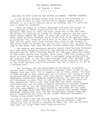
|
2017 jun 18
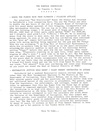
|
2017 jun 15
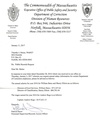
|
More... |
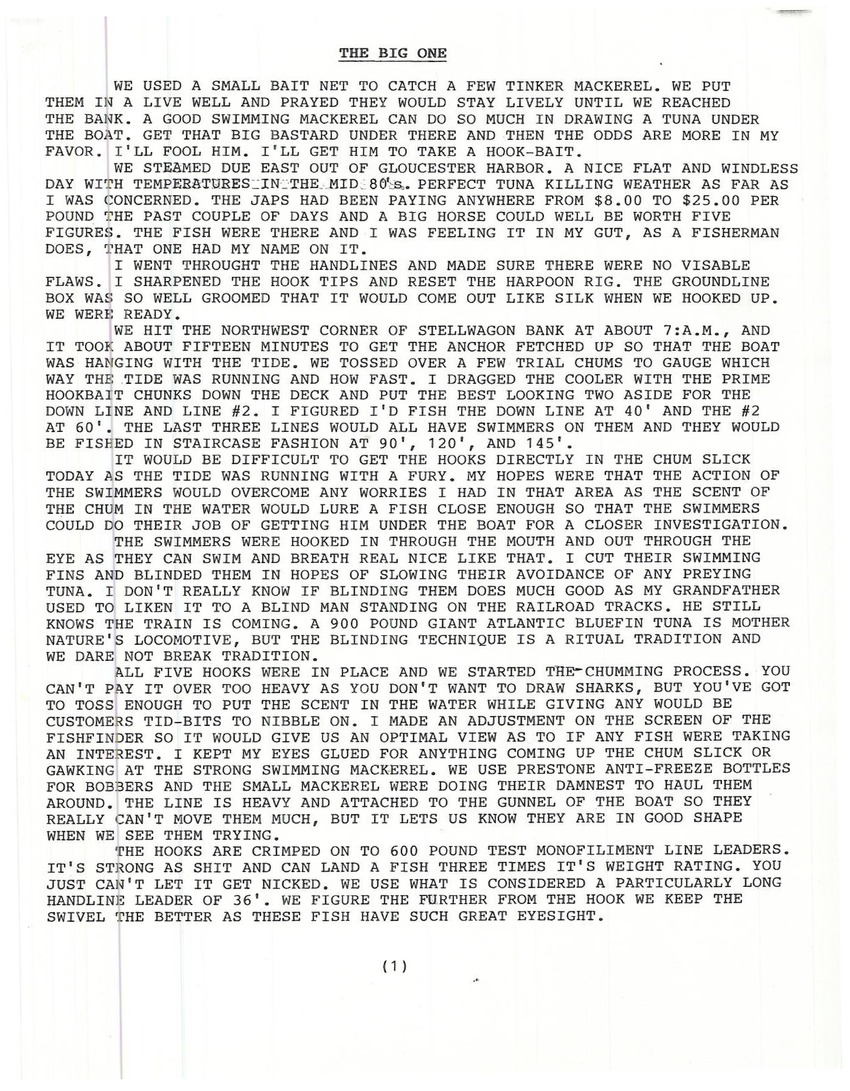
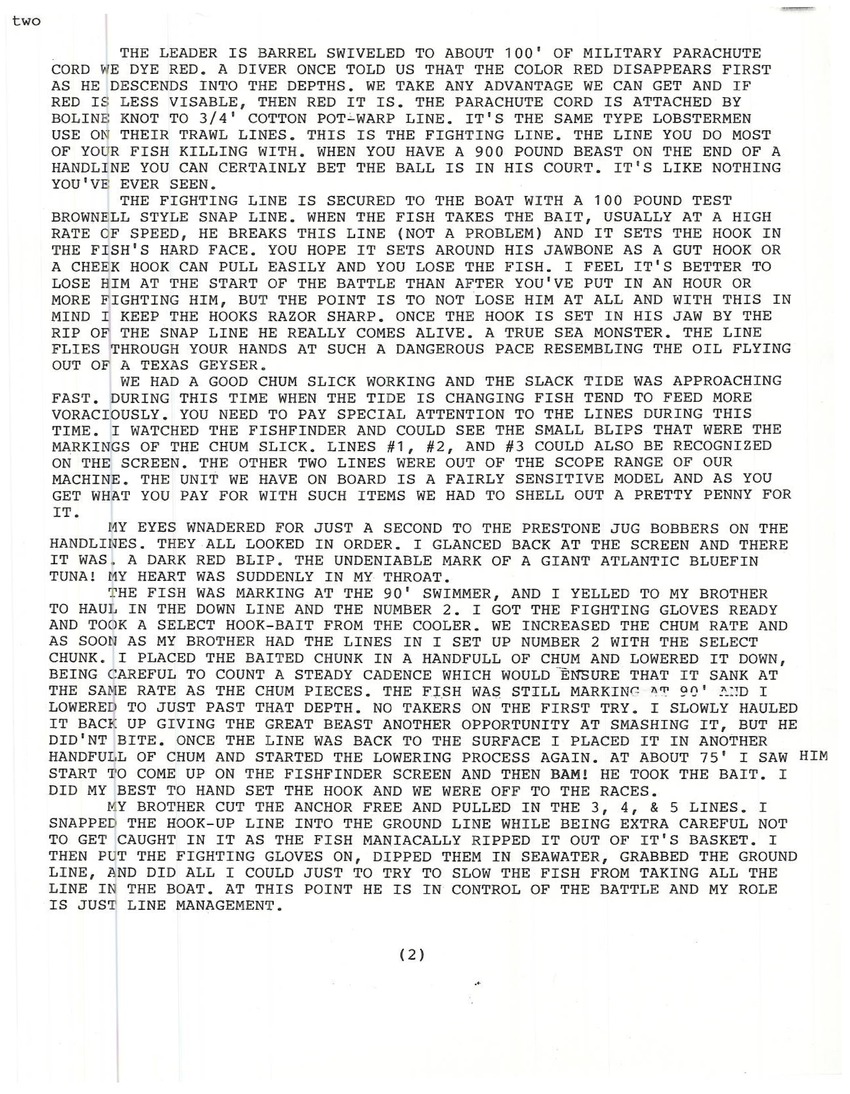
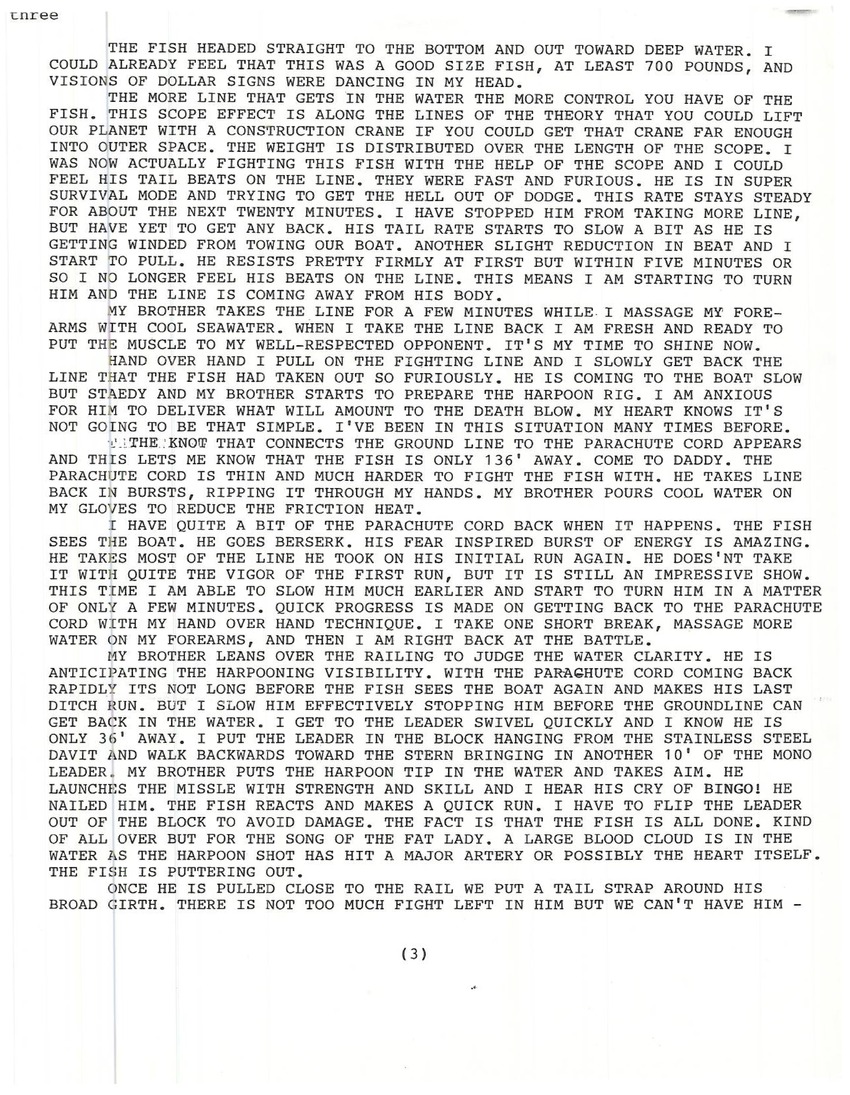
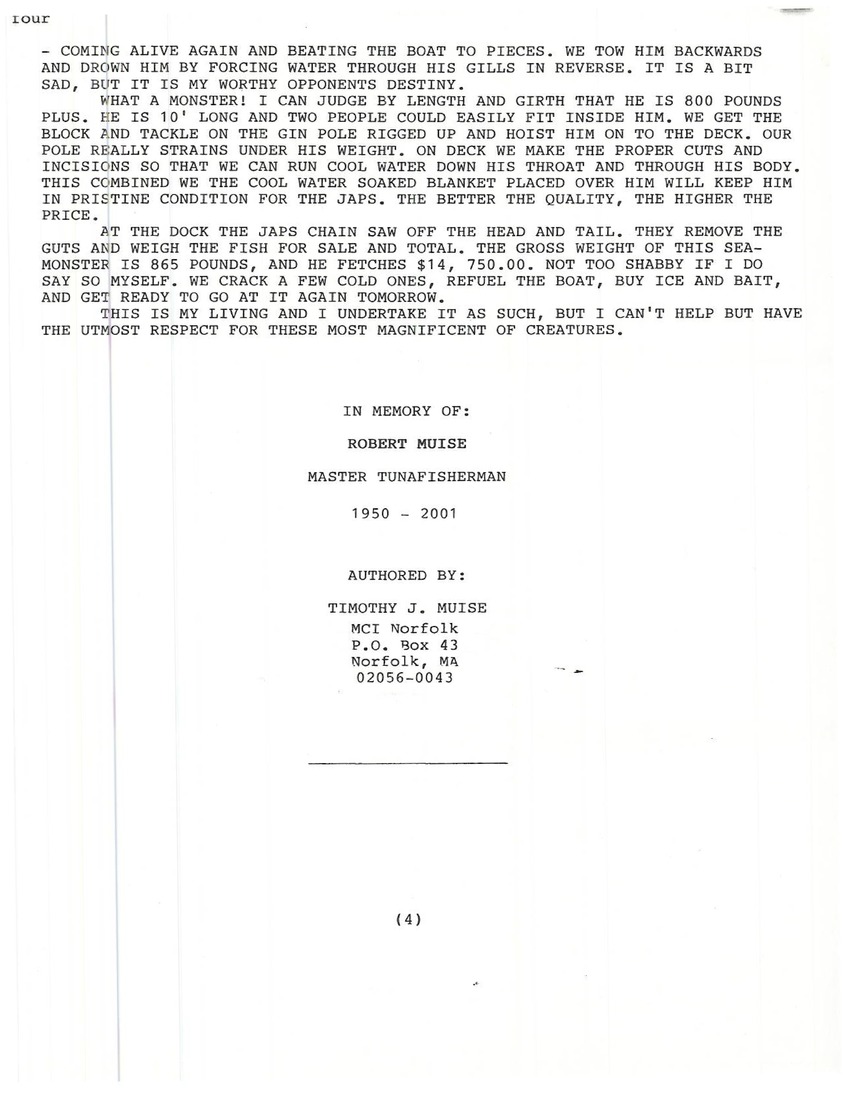

Replies (1)